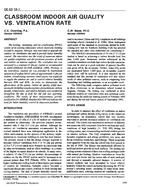Description
The heating, ventilating, and air conditioning (HVAC) system of an existing elementary school classroom building located in Augusta, Georgia, was renovated to upgrade the outdoor air ventilation rate and to provide better humidity control. The renovation was the result of numerous indoor air quality complaints and the persistent presence of mould and mildew on interior surfaces. The ventilation rate was increased to a constant 15 cfm per student as recommended in ANSI/ASHRAE 62-1989 (ASHRAE 1989). Previous to the renovation, outdoor air was provided by intermittent operation of rooftop HVAC units at approximately 5 cfm per student. A total energy recovery wheel system was employed to supply the outdoor air to control relative humidity between 30% and 60%. In order to demonstrate the effectiveness of the system, indoor air quality (IAQ) measurements including volatile organics, formaldehyde, carbon dioxide, temperature, and relative humidity were monitored throughout the day at both the old and new operating conditions. The results of these measurements provide justification for ASHRAE Standard 62-1989 and indicate the need for better humidity control in classroom facilities.
KEYWORDS: schools, rooms, air quality, indoor, air change rate, relative humidity, USA, modernising, sick buildings, moulds, outdoor air, heat recovery, performance, monitoring, measuring, organic compounds, formaldehyde, carbon dioxide, temperature, case studies.
Citation: Symposium, ASHRAE Trans., 1993, vol.99, part 2, paper number DE-93-1-1, 429-439, 7 figs, 2 tabs, refs.
Product Details
- Published:
- 1993
- File Size:
- 1 file , 660 KB
- Product Code(s):
- D-17571




